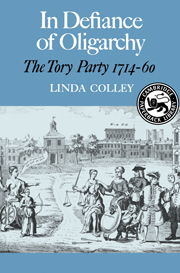Book contents
- Frontmatter
- Contents
- For my parents and Toby
- Preface
- Part I The Problem of Tory Survival
- Part II The Ingredients of Tory Survival
- Part III Single-Party Government Assailed
- 7 A Dark Hole with Blind Guides: 1714–24
- 8 The Twisted Threads of Party: 1725–41
- 9 Broad-Bottom Schemes and Princely Alliances: 1742–53
- 10 Acceptance and Dispersal? 1754 and Onwards
- Conclusion
- Appendix
- Manuscript Sources
- Notes
- Index
7 - A Dark Hole with Blind Guides: 1714–24
Published online by Cambridge University Press: 03 February 2010
- Frontmatter
- Contents
- For my parents and Toby
- Preface
- Part I The Problem of Tory Survival
- Part II The Ingredients of Tory Survival
- Part III Single-Party Government Assailed
- 7 A Dark Hole with Blind Guides: 1714–24
- 8 The Twisted Threads of Party: 1725–41
- 9 Broad-Bottom Schemes and Princely Alliances: 1742–53
- 10 Acceptance and Dispersal? 1754 and Onwards
- Conclusion
- Appendix
- Manuscript Sources
- Notes
- Index
Summary
The year 1714 witnessed not only the Hanoverian Succession, but also one of the most remarkable coups d‘etat ever staged. When Anne died the tories had a Commons majority of 208. The whigs’ concurrent reduction to 171 Members admittedly marked their post-1688 nadir, but their minority status at Westminster and in the constituencies had been the post-revolutionary norm. How was it, then, that Bolingbroke's prediction of March 1714 came to be fulfilled: ‘The minority, and that minority unpopular, must get the better of the majority who have the sense of the nation on their side’?
Much was owing to whig ruthlessness - a ruthlessness born of desperation and rendered effective by the superior organisation and cohesion of an embattled minority. Knowing they had rarely achieved power by due constitutional process, the whigs at the end of Anne's reign showed themselves willing to employ violence. After the Pretender's announcement in March 1714 that he would not convert to Anglicanism there is no evidence that any of Anne's tory ministers seriously considered his restoration. Neither after March nor before is there any firm evidence of tory military preparations to forestall the Hanoverian Succession. Some whigs, by contrast, were willing to risk civil war. Since 1712 the duke of Marlborough had been urging the Emperor and the Dutch and Hanoverian governments to invade Britain and overthrow the tory administration. By 1714 George Ludwig, the Elector of Hanover, had agreed that Marlborough would lead an invasion if a Stuart restoration seemed likely at Anne's death.
- Type
- Chapter
- Information
- In Defiance of OligarchyThe Tory Party 1714-60, pp. 177 - 203Publisher: Cambridge University PressPrint publication year: 1982



